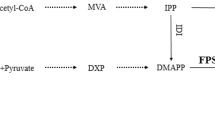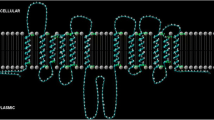Summary
The endoglucanase gene was sequenced fromPrevotella ruminicola AR20, isolated as clone pJW4. The endoglucanase (BrEND) is encoded by an open reading frame (ORF1) of 501 codons, corresponding to a protein of calculated molecular weight 55.7 kDa. Analysis of proteins on SDS-PAGE revealed a protein corresponding to the calculated molecular weight of the processed BrEND. The protein showed substantial homology to members of the A4 sub-family cellulases. Primer extension studies revealed that transcription ofcelA is initiated at different sites inEscherichia coli andPrevotella ruminicola. E. coli σ70 recognition sequences were identified, which were located upstream from the transcription initiation site (TIS) functional inE. coli. A longer extension product was identified using RNA fromP. ruminicola, indicating that the gene may normally be transcribed as part of a polycistronic message. The end of the primer extension product corresponded to a site beyond the 5′ boundary of the cloned fragment, thus preventing identification of native promoter sequences. A second ORF of 110 codons (ORF2) was identified on the antisense strand, and primer extension indicated that transcription through ORF2 was initiated at an identical site in bothE. coli andP. ruminicola. E. coli-like consensus sequences were located at positions −10 and −35 upstream from this site, suggesting that some promoter sequences inP. ruminicola are similar toE. coli consensus sequences, although others recognized byE. coli are non-functional inP. ruminicola. The presence of a strong potential ribosome-binding site at nucleotide positions 25–38 of the antisense transcript could indicate that ORF2 is translated inP. ruminicola; however, a protein corresponding to this ORF was not detected on SDS-PAGE. This suggests that it is more likely that ribosomal binding of the antisense transcript plays a part in translational regulation of endoglucanase expression.
Similar content being viewed by others
References
Asmundson RV, Huang C-M, Kelly WJ, Yu P-L, Curry MM (1990) The cellulase ofRuminococcus flavefaciens strain 186: characterization, cloning and use in ruminant nutrition In: Akin DE, Ljungdahl LG, Wilson JR, Harris PJ (eds) Microbial and plant opportunities to improve lignocellulose utilization by ruminants. Elsevier, New York, pp 401–409
Béguin P (1990) Molecular biology of cellulose degradation. Annu Rev Microbiol 44:219–248
Berger E, Jones WA, Jones DT, Woods DR (1989) Cloning and sequencing of an endoglucanase (end1) gene fromButyrivibrio fibrisolvens H17c. Mol Gen Genet 219:193–198
Berger E, Jones WA, Jones DT, Woods DR (1990) Sequencing and expression of a cellodextrinase (ced1) gene fromButyrivibrio fibrisolvens H17c cloned inEscherichia coli. Mol Gen Genet 223:310–318
Brosius J (1984) Plasmid vectors for the selection of promoters. Gene 27:151–160
Cavicchioli R, Watson K (1991) The involvement of transcriptional read-through from internal promoters in the expression of a novel endoglucanase gene inFibrobacter succinogenes AR1. Nucleic Acids Res 19:1661–1669
Cavicchioli R, East PD, Watson K (1991)endA FS, a novel family E endoglucanase gene fromFibrobacter succinogenes. J Bacteriol 173:3265–3268
Chomczynski P, Sacchi N (1987) Single step method of RNA isolation by acid guanidinium thiocyanate-phenol-chloroform extraction. Anal Biochem 162:156–159
Devereux J, Haeberli P, Smithies O (1984) A comprehensive set of sequence analysis programs for the VAX. Nucleic Acids Res 12:387–395
Dower WJ, Miller JF, Ragsdale CW (1988) High efficiency transformation ofE. coli by high voltage electroporation. Nucleic Acids Res 16:6127–6145
Flint HJ, Thomson AM (1991) The genetic manipulation of rumen bacteria with special reference to fibre digestion. Anim Feed Sci Technol 32:123–129
Fukumori F, Ohishi K, Kudo T, Horikoshi K (1987) Tandem location of the cellulase genes on the chromosome ofBacillus sp. strain N-4. FEMS Microbiol Lett 48:65–68
Gibson TJ (1984) Studies on the Epstein-Bar virus genome. PhD Thesis, Cambridge University, UK
Gierasch LM (1989) Signal sequences. Biochemistry 28:923–929
Green PJ, Pines O, Inouye M (1986) The role of antisense RNA in gene regulation. Annu Rev Biochem 55:569–597
Gregg K (1989) Genetic engineering of rumen bacteria. In: Rogers GE, Reis PJ, Ward KA, Marshall RC (eds) The biology of wool and hair. Chapman and Hall, London, pp 417–424
Hall J, Hazlewood GP, Barker PJ, Gilbert HJ (1988) Conserved reiterated domains inClostridium thermocellum endoglucanases are not essential for catalytic activity. Gene 69:29–38
Hall J, Hazlewood GP, Huskisson NS, Durrant AJ, Gilbert HJ (1989) Conserved serine-rich sequences in xylanase and cellulase fromPseudomonas fuorescens subspeciescellulosa: internal signal sequence and unusual protein processing. Mol Microbiol 3:1211–1219
Hanahan D (1985) Techniques for transformation ofE. coli. In: DNA cloning: A practical approach, vol 1, pp 109–135
Hawley DK, McClure WR (1983) Compilation and analysis ofEscherichia coli promoter DNA sequences. Nucleic Acids Res 11:2237–2255
Hazlewood GP, Davidson K, Laurie JI, Romaniec MPM, Gilbert HJ (1990) Cloning and sequencing of thecelA gene encoding endoglucanase A ofButyrivibrio fibrisolvens strain A46. J Gen Microbiol 136:2089–2097
Henrissat B, Claeyssens M, Tomme P, Lemesle L, Mornon J-P (1989) Cellulase families revealed by hydrophobic cluster analysis. Gene 81:83–95
Higgins DG, Sharp PM (1988) CLUSTAL: a package for performing multiple sequence alignment on a microcomputer. Gene 73:237–244
Janssen PJ, Jones DT, Woods DR (1990) Studies onClostridium acetobutylicum glnA promoters and antisense RNA. Mol Microbiol 4:1575–1583
Kellett LE, Poole DM, Ferreira LMA, Durrant AJ, Hazlewood GP, Gilbert HJ (1990) Xylanase B and an arabinofuranoside fromPseudomonas fluorescens subsp.cellulosa contain identical cellulose-binding domains and are encoded by adjacent genes. Biochem J 272:369–376
Laemmli UK (1970) Cleavage of structural proteins during the assembly of the head of bacteriophage T4. Nature 227:680–685
Lin L-L, Rumbak E, Zappa H, Thomson JA, Woods DR (1990) Cloning, sequencing and analysis of expression of aButyrivibrio fibrisolvens gene encoding a β-glucosidase. J Gen Microbiol 136:1567–1576
Maniatis T, Fritsch EF, Sambrook J (1982) Molecular cloning: A laboratory manual. Cold Spring Harbour Laboratory, Cold Spring Harbour, NY
Matsushita O, Russell JB, Wilson DB (1990) Cloning and sequencing of aBacteroides ruminicola B14 endoglucanase gene. J Bacteriol 172:3620–3630
Matsushita O, Russell JB, Wilson DB (1991) ABacteroides ruminicola 1,4,-β-D-endoglucanase is encoded in two reading frames. J Bacteriol 173:6919–6926
McGavin MJ, Forsberg CW, Crosby B, Bell AW, Dignard D, Thomas DY (1989) Structure of thecel-3 gene fromFibrobacter succinogenes S85 and characteristics of the encoded gene product, endoglucanase 3. J Bacteriol 171:5587–5595
Mead DA, Szczesna-Skorupa E, Kemper B (1986) Single-stranded DNA ‘blue’ T7 promoter plasmids: a versatile tandem promoter system for cloning and protein engineering. Protein Engineering 1:67–74
Moser B, Gilkes NR, Kilburn DG, Warren RAJ, Miller RC Jr (1989) Purification and characterization of endoglucanase C ofCellulomonas fimi, cloning of the gene, and analysis of in vivo transcripts of the gene. Appl Environ Microbiol 55:2480–2487
Ohmiya K, Kajino T, Kato A, Shimizu S (1989) Structure of aRuminococcus albus endo-1,4-β-glucanase gene. J Bacteriol 171:6771–6775
Ohmiya K, Takano M, Shimizu S (1990) DNA sequence of a β-glucosidase fromRuminococcus albus. Nucleic Acids Res 16:671
Poole DM, Hazlewood GP, Laurie JI, Barker PJ, Gilbert HJ (1990) Nucleotide sequence of theRuminococcus albus SY3 endoglucanase genescelA andcelB. Mol Gen Genet 223:217–223
Raleigh EA, Murray NE, Revel H, Blumenthal RM, Westaway AD, Rigby PWJ, Elhai J, Hanahan D (1988) McrA, McrB restriction phenotypes of someE. coli strains and implications for gene cloning. Nucleic Acids Res 16:1563–1575
Russell JB, Wilson DB (1988) Potential opportunities and problems for genetically altered rumen microorganisms. J Nutr 118:271–279
Sanger F, Nicklen S, Coulsen AR (1977) DNA sequencing with chain terminating inhibitors. Proc Natl Acad Sci USA 74:5463–5467
Schwarz WH, Schimming S, Staudenbauer WL (1988) Isolation of aClostridium thermocellum gene encoding a thermostable β-1,3-glucanase (laminarinase). Biotechnol Lett 10:225–230
Shah HN, Collins MD (1990)Prevotella, a new genus to includeBacteroides melaninogenicus and related species formerly classified in the genusBacteroides. Int J Syst Bacteriol 40:205–208
Shine J, Dalgarno L (1974) The 3′ terminal sequence ofEscherichia coli 16S ribosomal RNA: complementarity to nonsense triplets and ribosome binding sites. Proc Natl Acad Sci USA 71:1342–1346
Teather RM (1985) Application of gene manipulation to rumen microflora. Can J Anim Sci 65:563–574
Teather RM (1990) Structure of β-glucanase genes from rumen bacteria. In: Akin DE, Ljungdahl LG, Wilson JR, Harris PJ (eds) Microbial and plant opportunities to improve lignocellulose utilization by ruminants. Elsevier, New York, pp 377–388
Teather RM, Erfle JD (1990) DNA sequence of aFibrobacter succinogenes mixed linkage β-glucanase (1,3-1,4-β-D-glucan 4-glucanohydrolase) gene. J Bacteriol 172:3837–3841
Utt EA, Eddy CK, Keshav KF, Ingram LO (1991) Sequencing and expression of theButyrivibrio fibrisolvens xylB gene encoding a novel bifunctional protein with β-D-xylosidase and α-L-arabi-nofuranosidase activities. Appl Environ Microbiol 57:1227–1234
Wang W, Thomson JA (1990) Nucleotide sequence of thecelA gene encoding a cellodextrinase ofRuminococcus flavefaciens FD-1. Mol Gen Genet 222:265–269
Watson MEE (1984) Compilation of published signal sequences. Nucleic Acids Res 12:5145–5164
Weisburg WG, Oyaizu Y, Oyaizu H, Woese CR (1985) Natural relationship betweenBacteroides andFlavobacter. J Bacteriol 164:230–236
Whitehead TR, Hespell RB (1990) The genes for three xylandegrading activities fromBacteroides ovatus are clustered in a 3.8-kilobase region. J Bacteriol 172:2408–2412
Woods JR, Hudman F, Gregg K (1989) Isolation of an endoglucanase gene fromBacteroides ruminicola subsp.brevis. J Gen Microbiol 135:2543–2549
Wynne EC, Pemberton JM (1986) Cloning of a gene cluster fromCellvibrio mixtus which codes for cellulose, chitinase, amylase, and pectinase. Appl Environ Microbiol 52:1362–1367
Yanisch-Perron C, Vieira J, Messing J (1985) Improving M13 phage cloning vectors and host strains: nucleotide sequences of the M13mp18 and pUC19 vectors. Gene 33:103–119
Author information
Authors and Affiliations
Rights and permissions
About this article
Cite this article
Vercoe, P.E., Gregg, K. DNA sequence and transcription of an endoglucanase gene fromPrevotella (Bacteroides) ruminicola AR20. Molec. Gen. Genet. 233, 284–292 (1992). https://doi.org/10.1007/BF00587590
Received:
Issue Date:
DOI: https://doi.org/10.1007/BF00587590




